Site Li
Cabot Corporation
Social
Email
Scholar
ORCID
GitHub
LinkedIn
Contact:
Building 2
Cabot Corporation
157 Concord RD
Billerica, MA 02148
sitecmu@gmail.com
Selected Publications
Full list @ Google Scholar
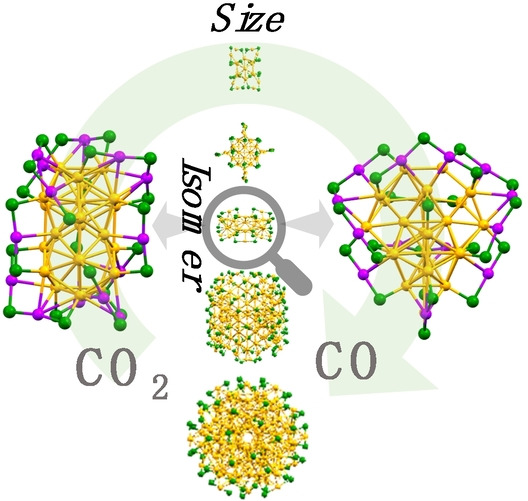 |
Dissecting Critical Factors for Electrochemical CO2 Reduction on Atomically Precise Au Nanoclusters
This work investigates the critical factors impacting electrochemical CO2 reduction reaction (CO2RR) using atomically precise Au nanoclusters (NCs) as electrocatalysts. First, the influence of size on CO2RR is studied by precisely controlling NC size in the 1–2.5 nm regime. We find that the electrocatalytic CO partial current density increases for smaller NCs, but the CO Faradaic efficiency (FE) is not directly associated with the NC size. This indicates that the surface-to-volume ratio, i.e. the population of active sites, is the dominant factor for determining the catalytic activity, but the selectivity is not directly impacted by size. Second, we compare the CO2RR performance of Au38 isomers (Au38Q and Au38T) to reveal that structural rearrangement of identical size NCs can lead to significant changes in both CO2RR activity and selectivity. Au38Q shows higher activity and selectivity towards CO than Au38T, and density functional theory (DFT) calculations reveal that the average formation energy of the key *COOH intermediate on the proposed active sites is significantly lower on Au38Q than Au38T. These results demonstrate how the structural isomerism can impact stabilization of reaction intermediates as well as the overall CO2RR performance of identical size Au NCs. Overall, this work provides important structure–property relationships for tailoring the NCs for CO2RR.
|
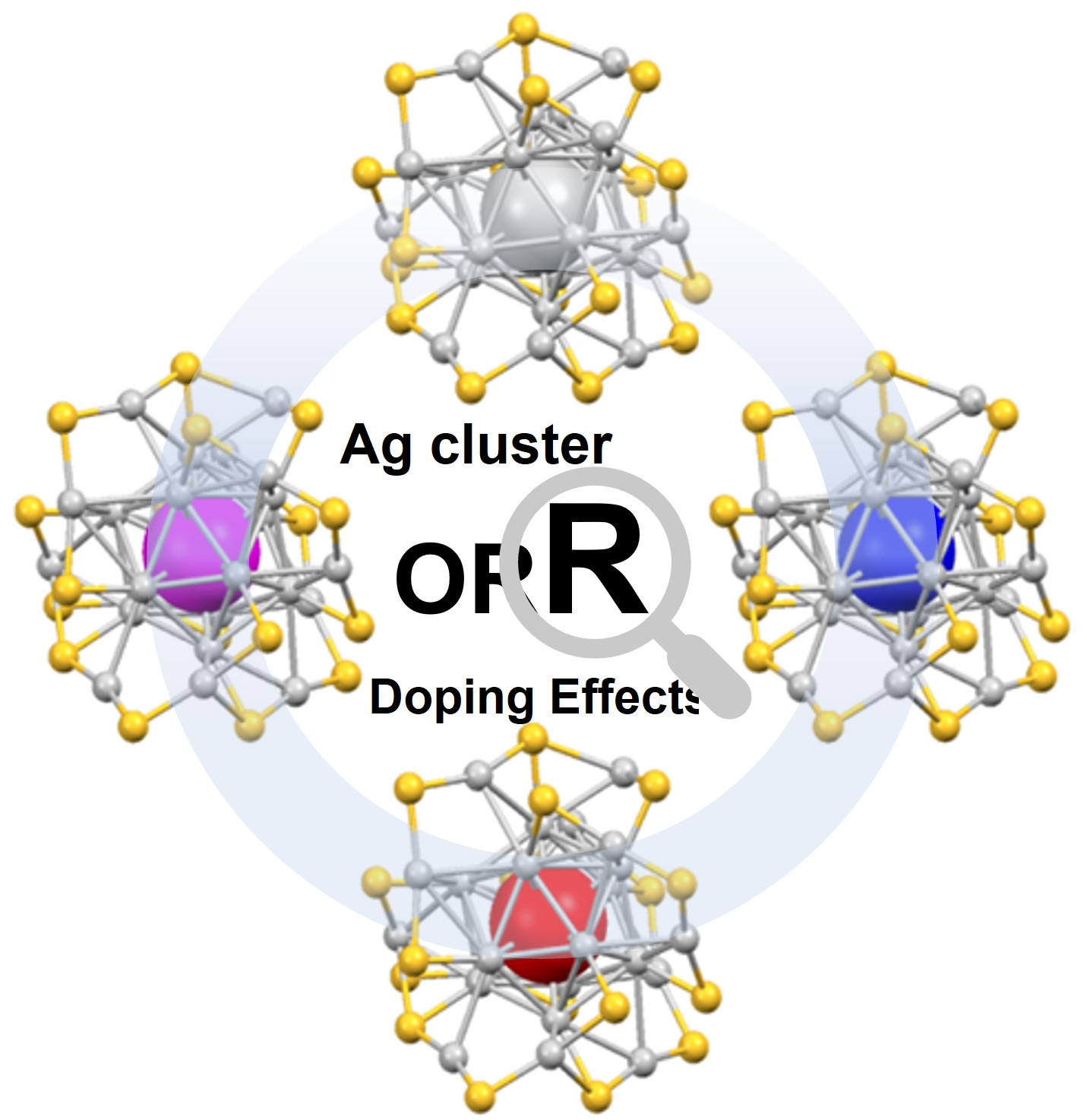 |
Understanding the Single Atom Doping Effects in Oxygen Reduction with Atomically Precise Metal Nanoclusters
As a critical part of the fuel cell system, the oxygen reduction reaction (ORR) has been extensively investigated. Here we report the ORR performance catalyzed by atomically precise, heterometal-doped Ag nanoclusters (NCs). It is observed that Ag NCs with a single palladium or platinum atom doped in the kernel exhibit better ORR performance, with a ∼100 mV lower onset potential compared with the monometallic counterpart. Density functional theory calculations demonstrate that the single-atom doping can impact the ORR performance by tuning the energy required for active-site exposure on the surface and the *OOH formation energy on the exposed active sites. We find the exposure of sulfur active sites on the surface of the NCs to be thermodynamically more feasible than the exposure of metal sites under an applied potential of −0.8 V vs Ag/AgCl. The formation energy of the *OOH intermediate on the catalytically active sites of the palladium- and platinum-doped NCs is nearly thermoneutral, which, in turn, translates to their higher catalytic activity. Overall, computational and experimental results consistently demonstrate the higher electrocatalytic activity of the doped NCs for the ORR. This study offers insights into the doping effects of atomically precise NCs for electrocatalytic reactions.
|
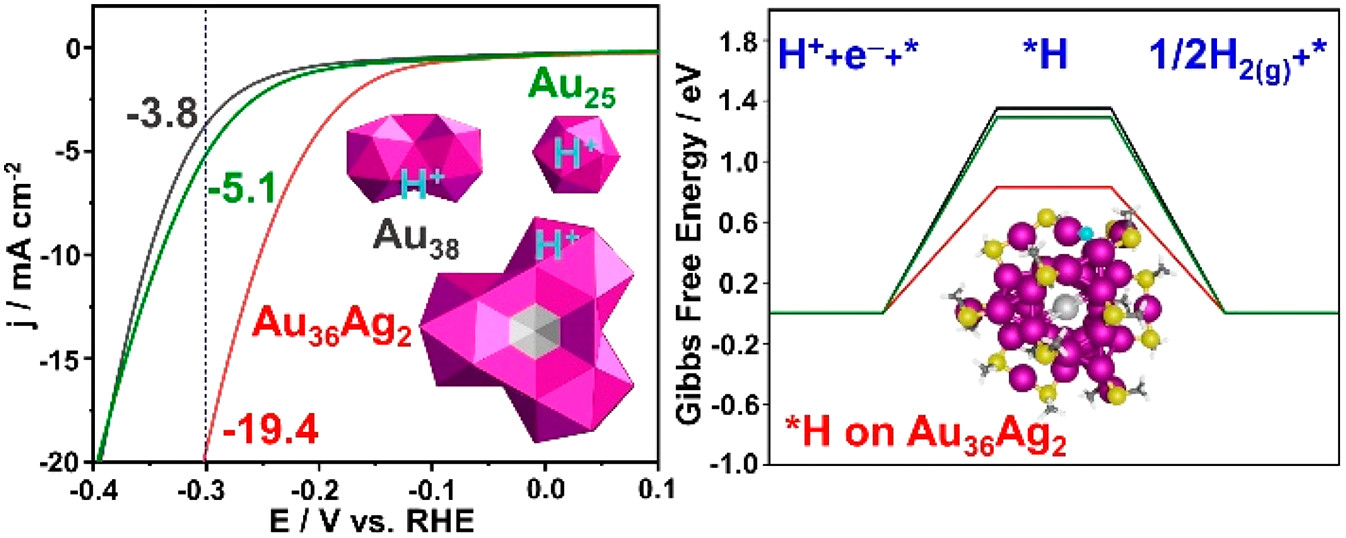 |
Hydrogen Evolution Electrocatalyst Design: Turning Inert Gold into Active Catalyst by Atomically Precise Nanochemistry
Electrocatalytic hydrogen evolution reaction (HER) holds promise in the renewable clean energy scheme. Crystalline Au and Ag are, however, poor in catalyzing HER, and the ligands on colloidal nanoparticles are generally another disadvantage. Herein, we report a thiolate (SR)-protected Au36Ag2(SR)18 nanocluster with low coverage of ligands and a core composed of three icosahedral (Ih) units for catalyzing HER efficiently. This trimeric structure, together with the monomeric Ih Au25(SR)18– and dimeric Ih Au38(SR)24, constitutes a unique series, providing an opportunity for revealing the correlation between the catalytic properties and the catalyst’s structure. The Au36Ag2(SR)18 surprisingly exhibits high catalytic activity at lower overpotentials for HER due to its low ligand-to-metal ratio, low-coordinated Au atoms and unfilled superatomic orbitals. The current density of Au36Ag2(SR)18 at −0.3 V vs RHE is 3.8 and 5.1 times that of Au25(SR)18– and Au38(SR)24, respectively. Density functional theory (DFT) calculations reveal lower hydrogen binding energy and higher electron affinity of Au36Ag2(SR)18 for an energetically feasible HER pathway. Our findings provide a new strategy for constructing highly active catalysts from inert metals by pursuing atomically precise nanoclusters and controlling their geometrical and electronic structures.
|
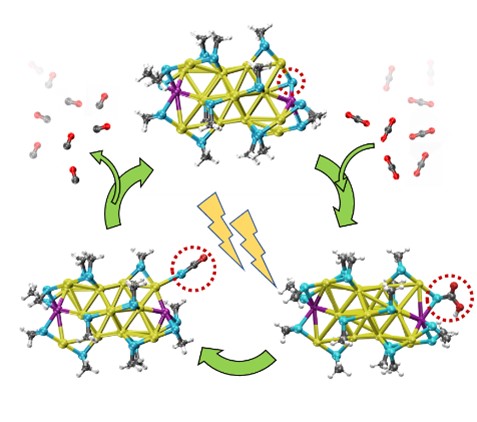 |
Boosting CO2 electrochemical reduction with atomically precise Surface modification on gold nanoclusters
Thiolate-protected gold nanoclusters are promising catalytic materials for CO2 electrochemical reduction (CO2RR), and their atomically precise size and structure as well as tunable composition render such materials particularly useful in fundamental studies. In this work we investigate CO2RR through an atomic level modification on a Au23 nanocluster by substituting two surface gold atoms with two cadmium (Cd) atoms. Such a modification of the surface structure greatly enhances the CO2RR selectivity to 90% - 95% at the applied potential between -0.5 V to -0.9 V, which is doubled compared with that of the undoped Au23. Additionally, when compared to the reported nanoclusters, the Cd-doped Au19Cd2 nanocluster exhibits the highest CO2RR activity (with 2200 mA mg-1 at -1.0 V vs reversible hydrogen electrode). This unique synergetic effect between Au and Cd is remarkable. Density functional theory (DFT) calculations reveal that the exposure of a sulfur active site upon partial ligand removal from the cluster surface provides an energetically feasible CO2RR reaction pathway. The thermodynamic energy barrier for product (CO) formation is 0.74 eV lower on the Au19Cd2 nanocluster compared to the Au23 nanocluster. The consistent experimental observation and calculation results reveal that Cd doping can greatly boost the CO2RR performance of Au nanoclusters by modifying both the surface geometry and electronic structure, which further changes the intermediate binding energy. This work offers insights into the surface doping mechanism of CO2RR and bimetallic synergism.
|
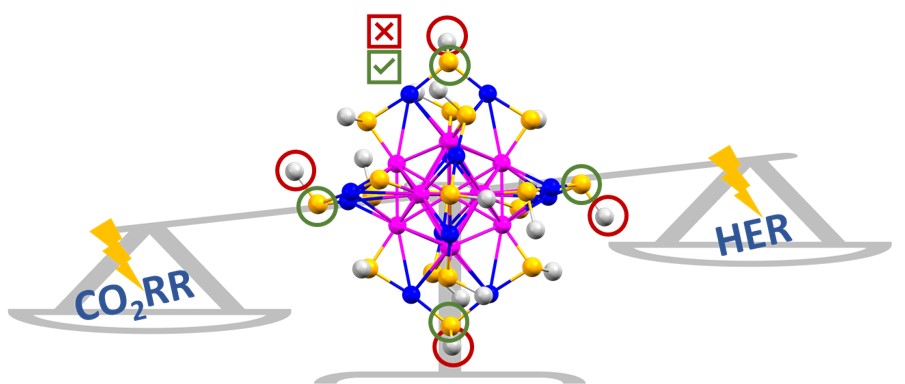 |
The Role of Ligands in Atomically Precise Nanocluster-Catalyzed CO2 Electrochemical Reduction
Ligand effects are of major interest in catalytic reactions owing to their potential critical role in determining the reaction activity and selectivity. Herein, we report ligand effects in CO2 electrochemical reduction reaction at the atomic level with three unique Au25 nanoclusters comprising the same kernel but different protecting ligands (-XR, where X = S or Se, and R represents the carbon tail). It is observed that a change in carbon tail shows no obvious impact on the catalytic selectivity and activity, but the anchoring atom (X = S or Se) strongly affects the electrocatalytic selectivity. Specifically, the S site acts as the active site and sustains CO selectivity, while the Se site shows a higher tendency of hydrogen evolution. Density functional theory (DFT) calculations reveal that the energy penalty associated with *COOH formation is lower on the S site by 0.26 eV compared to the Se site. Additionally, the formation energy of the product (*CO) is lower on the sulfur-based Au nanocluster by 0.43 eV. We attribute these energetic differences to the higher electron density on the sulfur sites of the Au nanocluster, resulting in modified bonding character of the reaction intermediates that reduce the energetic penalty for COOH and *CO formation. Overall, this work demonstrates that S/Se atoms at the metal-ligand interface can play an important role in determining the overall electrocatalytic performance of Au nanoclusters.
|
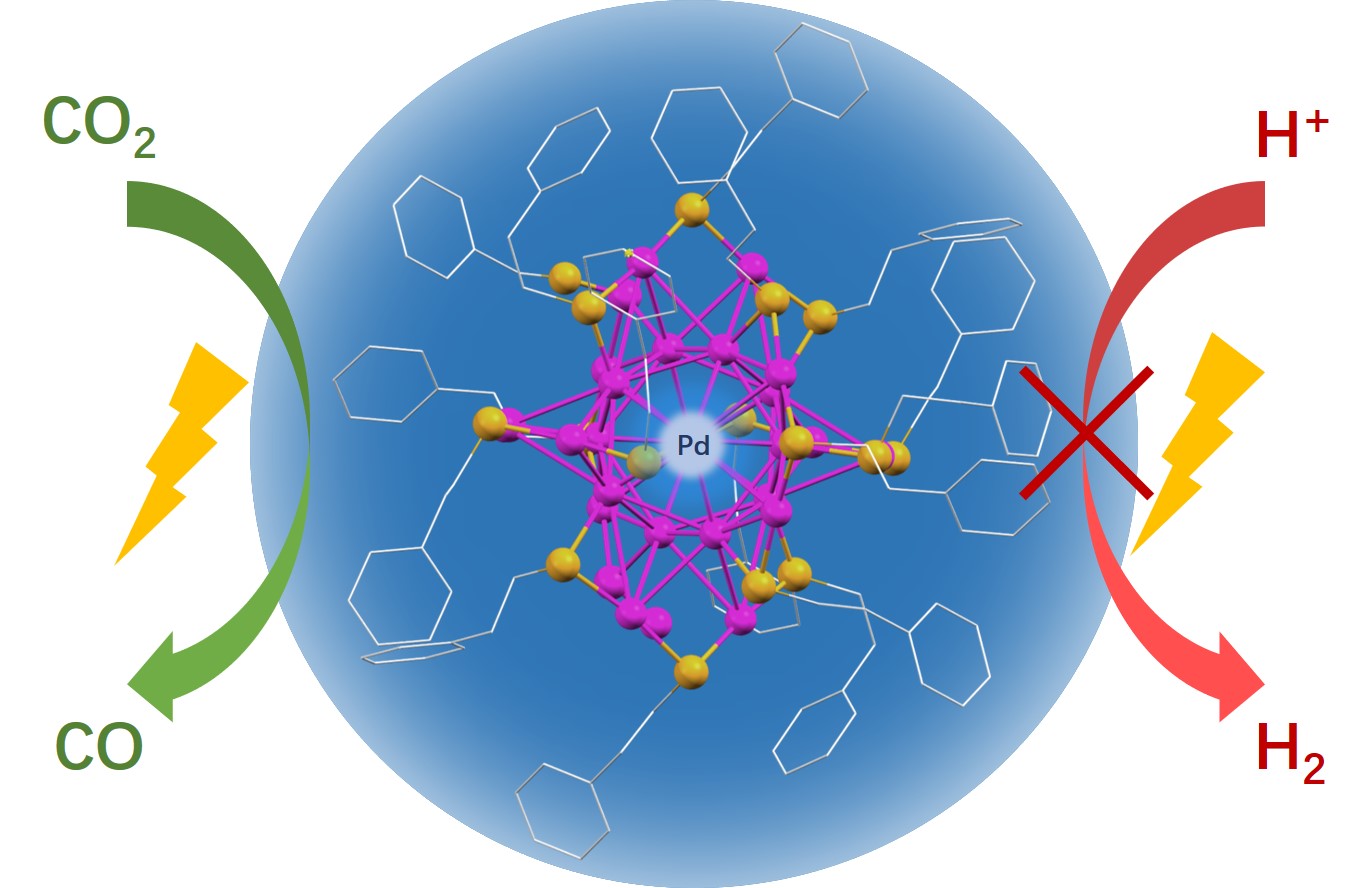 |
Mono-Palladium Substitution in Gold Nanoclusters Enhances CO2 Electroreduction Activity and Selectivity
Atomically precise gold nanoclusters provide opportunities for correlating the structure and electrocatalytic properties at the atomic-level. Here, we report the singe-atom doping effect on CO2 reduction by comparing mono-palladium doped Pd1Au24 and homogold Au25 nanoclusters (both protected by thiolates) that share an identical core structure. Experimental results show that single Pd substitution drastically inhibits H2 evolution at large currents, thus, Pd1Au24 can convert CO2 to CO with ~100% Faradaic efficiency ranging from -0.2 V (onset) to -1.2 V (vs. RHE), while Au25 starts to decline at -0.9 V. Theoretical simulations reveal that the Pd dopant influences the Au nanocluster properties through a unique mechanism different than in conventional alloy nanoparticles. The surface S atoms of the thiolate ligand are identified as the active sites (with the Au13 core as the electron reservoir) for selective CO2 reduction, whereas undercoordinated Au atom active sites are predicted to favor H2 evolution. Thermodynamic analysis of the ligand removal process predicts that Pd1Au24 should retain a larger population of S atom active sites under cathodic potentials compared with Au25, which extends the potential range for selective CO2 reduction. Our results demonstrate that single-atom substitution can substantially improve the CO2 reduction selectivity of gold nanoclusters at large potentials. The dopant-induced ligand stability may serve as a design strategy to modify the stability of catalytic active-sites under harsh conditions.
|
 |
Atomically Precise Nanoclusters as Electrocatalysts
This chapter summaries recent advances in electrocatalytic application of atomically precise metal nanoclusters (NCs). Metal nanoclusters with determined structures can serve as new model catalysts for electrochemical catalytic study at the atomic level and offer insights into the underlying mechanisms. In recent years, electrocatalysis by metal nanoclusters has been reported and shows promise in several important reactions, including oxygen reduction reaction, water splitting, and CO2 reduction reaction. By tuning the structure/ligand of the metal nanoclusters, it is possible to achieve catalytic property modification at the atomic level. Overall, the new material of atomically precise metal nanoclusters holds great promise in precise control of catalytic properties and investigation of the fundamental catalytic mechanism at the atomic level.
|
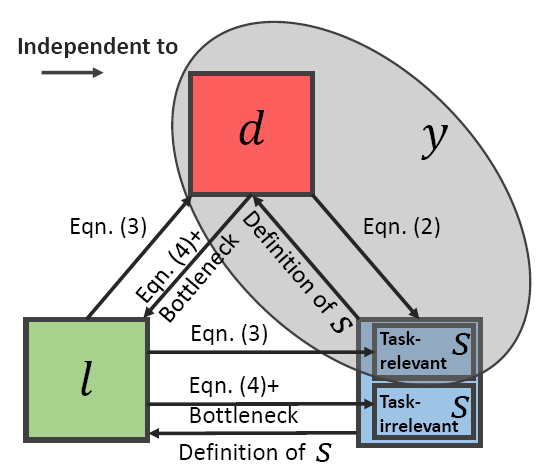 |
Feature-level Frankenstein: Eliminating Variations for Discriminative Recognition
Recent successes of deep learning-based recognition rely on maintaining the content related to the main-task label. However, how to explicitly dispel the noisy signals for better generalization remains an open issue. We systematically summarize the detrimental factors as task-relevant/irrelevant semantic variations and unspecified latent variation. In this paper, we cast these problems as an adversarial minimax game in the latent space. Specifically, we propose equipping an end-to-end conditional adversarial network with the ability to decompose an input sample into three complementary parts. The discriminative representation inherits the desired invariance property guided by prior knowledge of the task, which is marginally independent to the task-relevant/irrelevant semantic and latent variations. Our proposed framework achieves top performance on a serial of tasks, including digits recognition, lighting, makeup, disguise-tolerant face recognition, and facial attributes recognition.
|
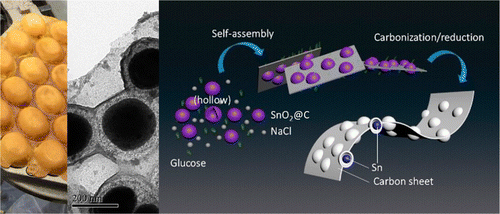 |
Yolk–Shell Sn@C Eggette-like Nanostructure: Application in Lithium-Ion and Sodium-Ion Batteries
Yolk–shell carbon encapsulated tin (Sn@C) eggette-like compounds (SCE) have been synthesized by a facile method. The SCE structures consist of tin cores covered by carbon membrane networks with extra voids between the carbon shell and tin cores. The novel nanoarchitectures exhibit high electrochemical performance in both lithium-ion batteries (LIBs) and sodium-ion batteries (SIBs). As anodes for LIBs, the SCE electrodes exhibit a specific capacity of ∼850 mA h g-1 at 0.1 C (100 mA g-1) and high rate capability (∼450 mA h g-1 remains) at high current densities up to 5 C (5000 mA g-1). For SIBs, the SCE electrodes show a specific capacity of ∼400 mA h g-1 at 0.1 C and high rate capacity (∼150 mA h g-1 remains) at high current densities up to 5 C (5000 mA g-1).
|
 |
Carbon fiber cloth@VO2 (B): excellent binder-free flexible electrodes with ultrahigh mass-loading
Flexible batteries have attracted much attention in recent years due to their promising applications in flexible displays, portable consumer electronic devices, and thin-film-based electronics. However, their practical applications are still limited by their low active material mass-loading in flexible electrodes and poor lithium storage performances. In this work, we have successfully grown highly crystalline VO2 nanobelt arrays on carbon fiber cloth (CFC) for the first time. The strategy only involves a facile one-pot solvothermal method. As binder-free flexible electrodes for LIBs, even with active material mass loading dramatically reaching up to 5.2 mg per square centimeter, such a novel CFC@VO2 (B) nanobelt array cathode electrode still exhibits a specific capacity of 145 mA h g-1 (90% of theoretical capacity), excellent cyclability with capacity retention over 90% after 200 cycles at ∼9C (1000 mA g-1), and high rate capability at high current densities up to ∼20C (2000 mA g-1). Such an excellent cathode material is very desirable in high-power flexible LIBs. The effective combination of CFC and a high areal mass loading of active materials described in this paper is a feasible and effective solution to design high-performance flexible batteries, especially high-power flexible batteries.
|
 |
Hollow bean-pod-like SiO2-supported-SnO2/C nanocomposites for durable lithium and sodium storage
In order to better resolve the large volume expansion problem of SnO2-based anode materials, a hollow bean-pod-like SiO2-supported-SnO2/C nanostructure with a sufficient internal void space is designed. Dual voids exist in this structure in combination with a SiO2 support in the core and carbon as an outside shell, providing triple guarantees to improve the performance of SnO2-based anode materials for Li and Na storage. As a result, after 550 charge/discharge cycles, a discharge capacity of 649 mA h g-1 can still be obtained for Li storage, and a discharge capacity of 104 mA h g-1 can still be maintained after 1000 charge/discharge cycles for Na storage.
|